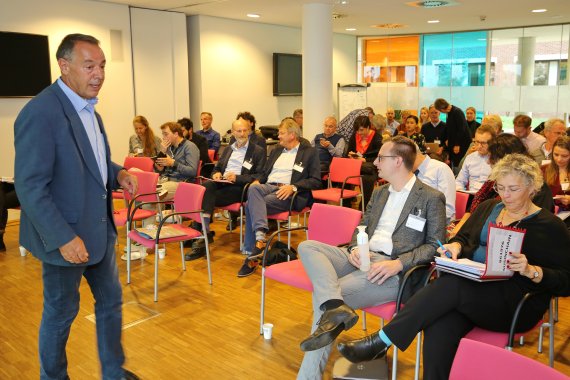The demand for insects for use in food and feed exceeds the European supply. An EU project coordinated by WUR is therefore looking for a competitive upscaling of the insect chain. The participants met in Wageningen on 7 and 8 October.
Insects such as black soldier flies, houseflies, mealworms and crickets form a sustainable protein source, because these insects can be grown on residual streams from the food and animal feed industry and contain a lot of healthy proteins. Insects are already used in feed for dogs and cats as well as processed in aquaculture feed. The demand has surpassed supply, says Teun Veldkamp, researcher animal nutrition at Wageningen Livestock Research. And that demand will only increase further as the EU is expected to adopt legislation that will allow the processing of insects in poultry and pig feed.
Scaling up
Veldkamp is the coordinator of the EU project Susinchain (Sustainable Insect Chain), which aims to develop knowledge and innovations for a competitive insect chain in Europe. Veldkamp’s main goal is scaling up existing insect farmers in order to reduce costs, because the insect feed is much more expensive than the fish meal and soybean meal that is currently used as feed.
Substrate
This is not simply about increasing production but also about the quality of the proteins. ‘The insects grow on residual streams such as vegetable and fruit residues. That substrate must meet requirements’, Veldkamp says. ‘This will become increasingly important if we also want to use food residues from restaurants, consumer kitchens and supermarkets as insect feed in the future. This means we must develop quality and safety guidelines for the substrates used in insect farming.’
Diseases
The EU project will also make an inventory of the preventive measures against diseases and pests available to insect farmers and of the circumstances under which insects and larvae should be transported. ‘The precursors handle both the reproduction and growing of insects, but I think that, similar to pig farming, specialised companies will arise for reproduction, as that is a difficult process.’ The project will also collect knowledge on how to process the insects safely.
Companies
The EU project focuses mainly on innovations and knowledge exchange, more so than on research. The project connects 17 knowledge institutions to 18 companies, including insect farmers and feed suppliers. Three WUR science groups are participating. Wageningen Livestock Research will be testing insect feed on pigs and poultry, Wageningen Food Safety Research will work on safety, and the Business Economics chair group will develop successful business models and production chains for insect farming.
Cookies
The EU expects the volume of insect production in Europe to increase by a factor of 1000 in the coming years. This should lead to 10 percent of the feed being made from insect proteins, as well as 20 percent of the proteins for human consumption. Veldkamp does not assume people will suddenly buy mealworm and cricket burgers for dinner. He expects the insects will primarily be an ingredient for regular food. ‘We won’t be getting cookies with a cricket on top of them, but cookies with crickets in them.’
The EU is investing 8 million euros in Susinchain, which will last four years.

 Teun Veldkamp opens the Susinchain meeting, Photo: Eddy Teenstra
Teun Veldkamp opens the Susinchain meeting, Photo: Eddy Teenstra